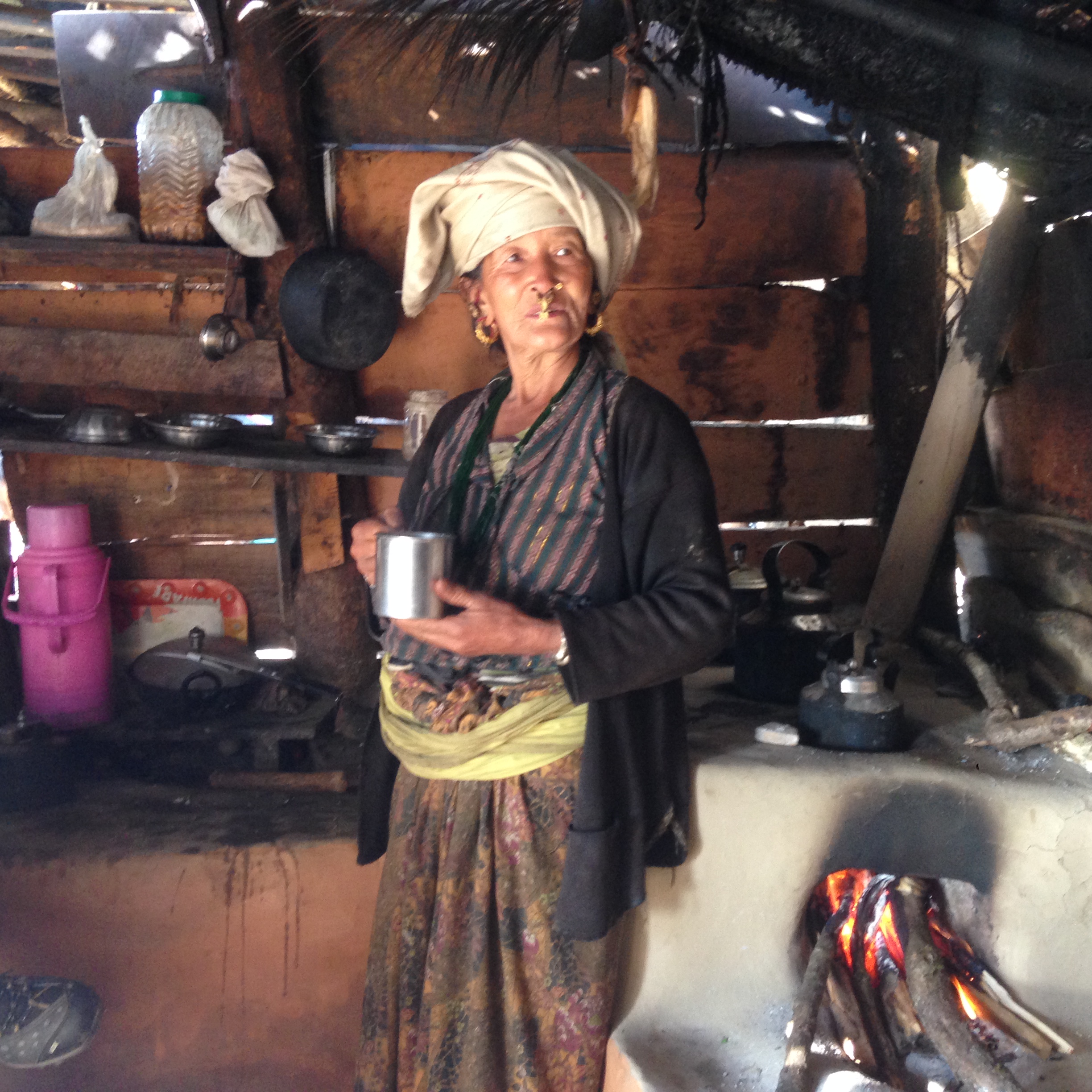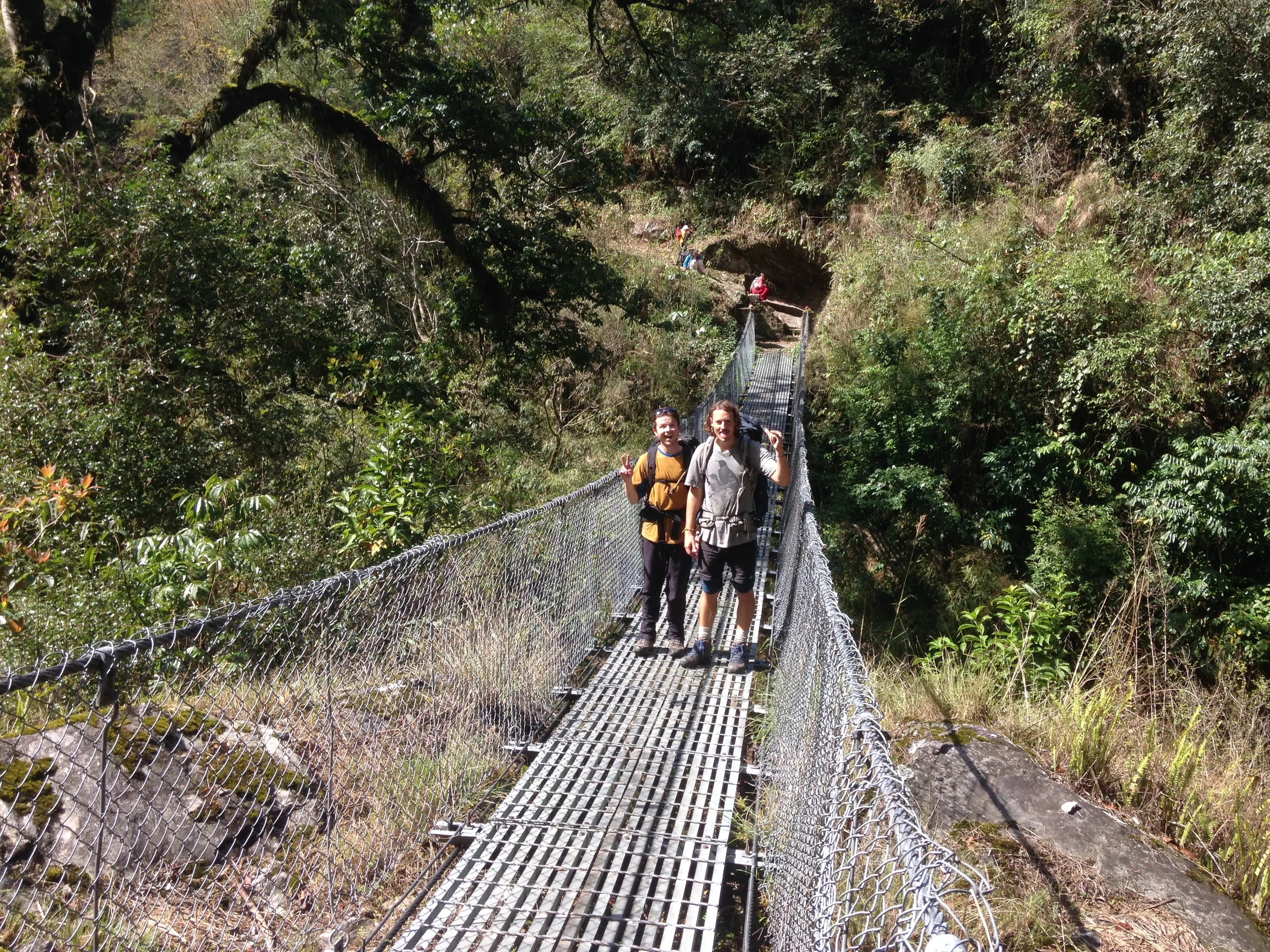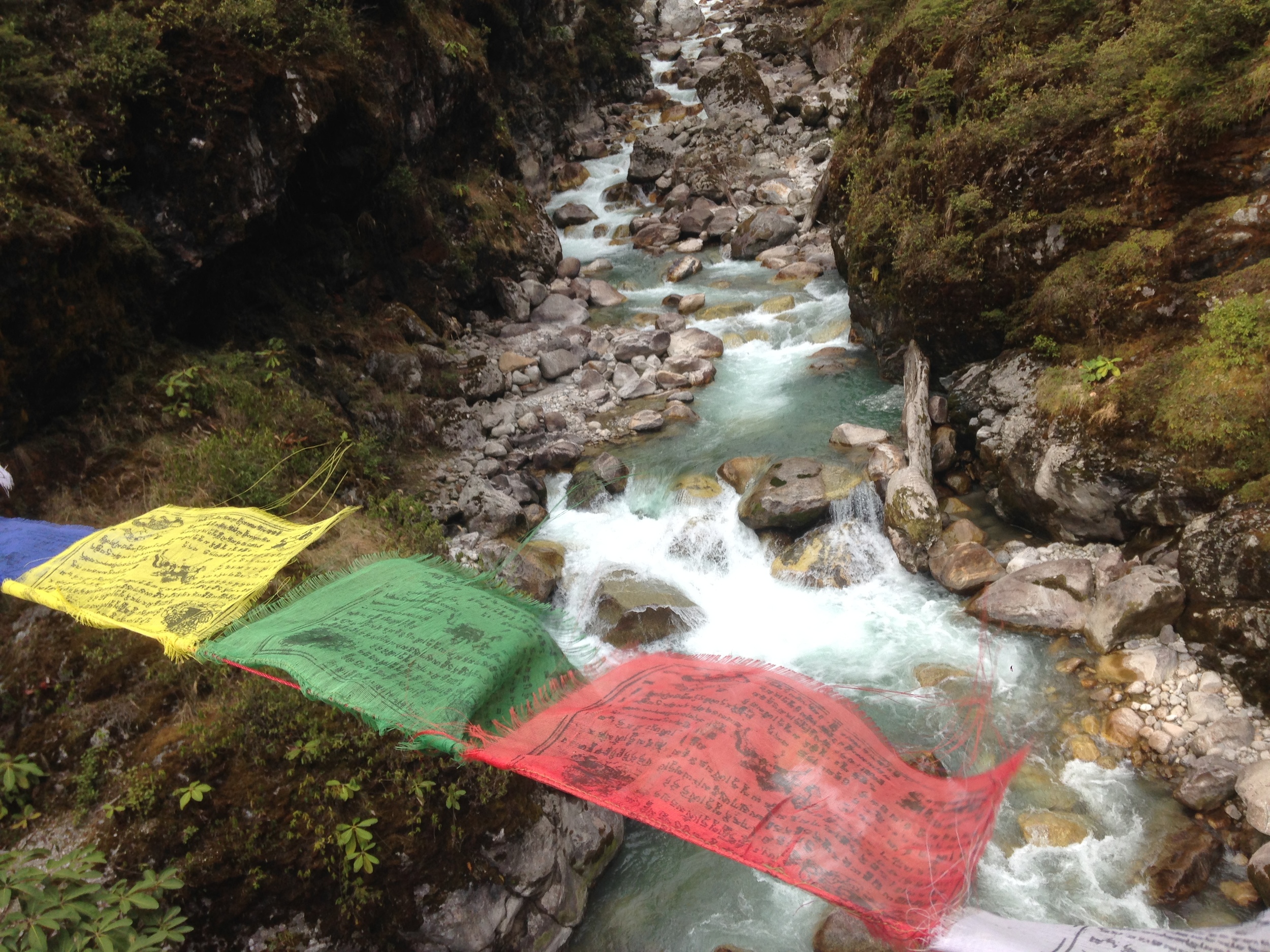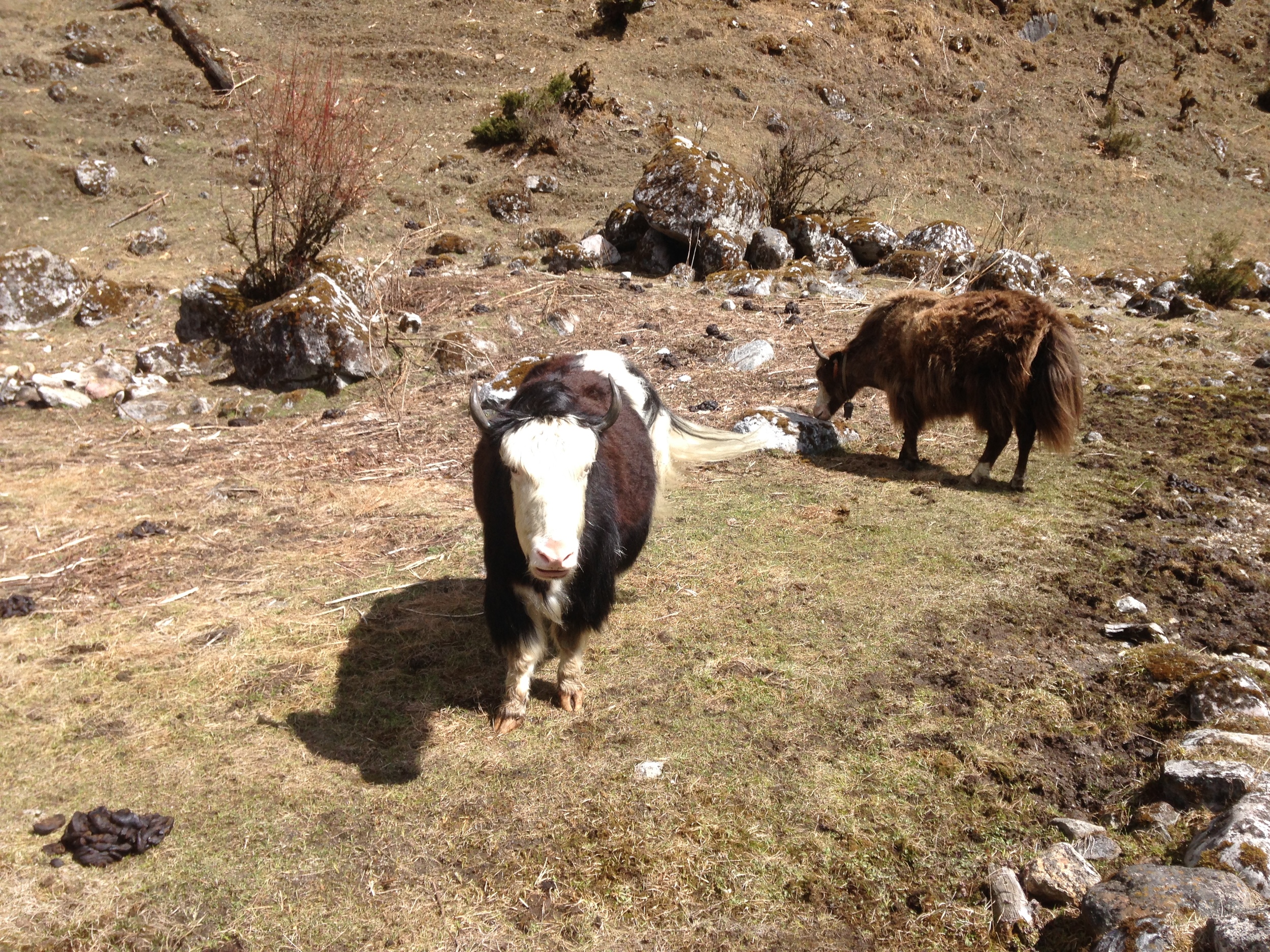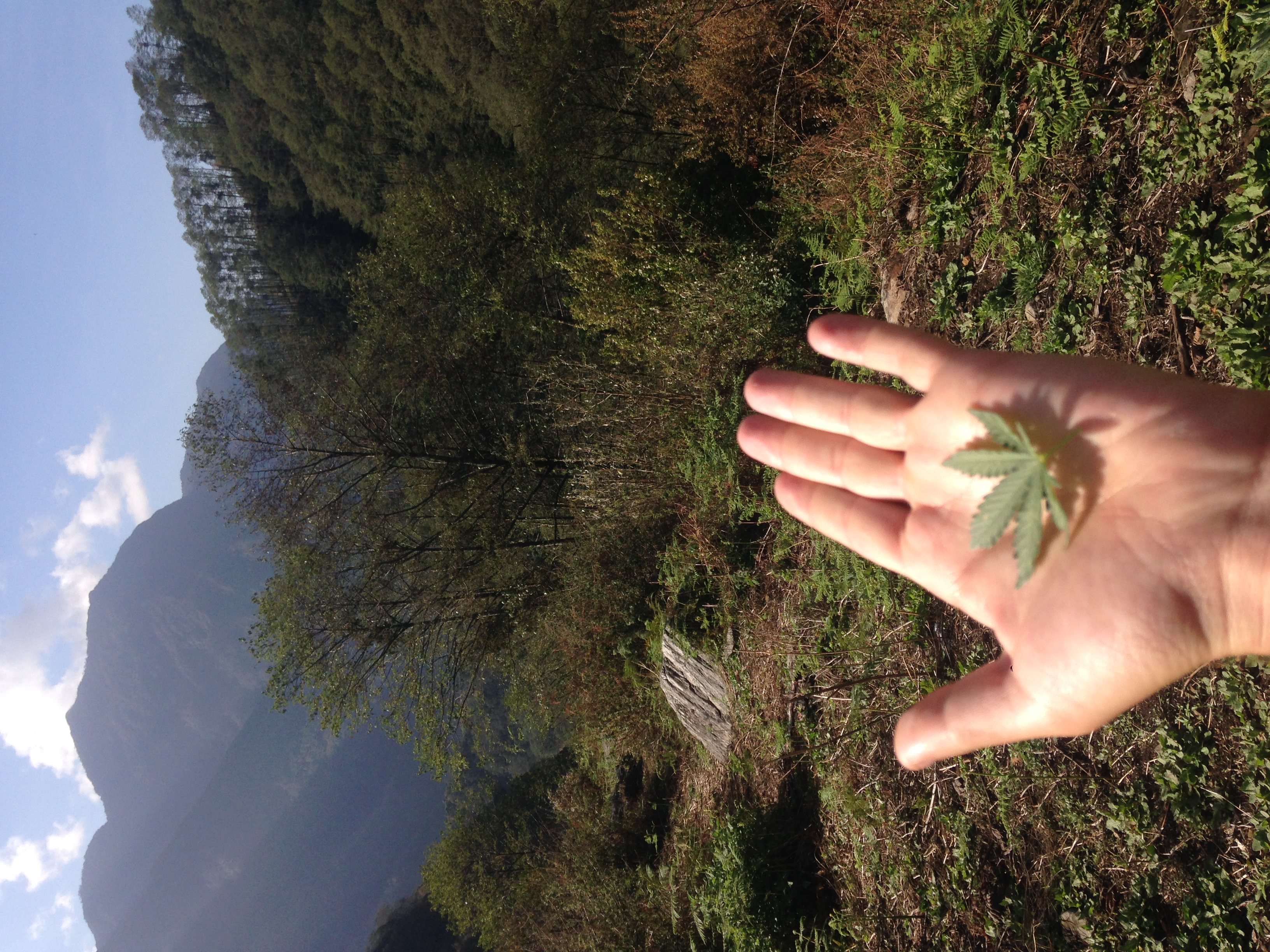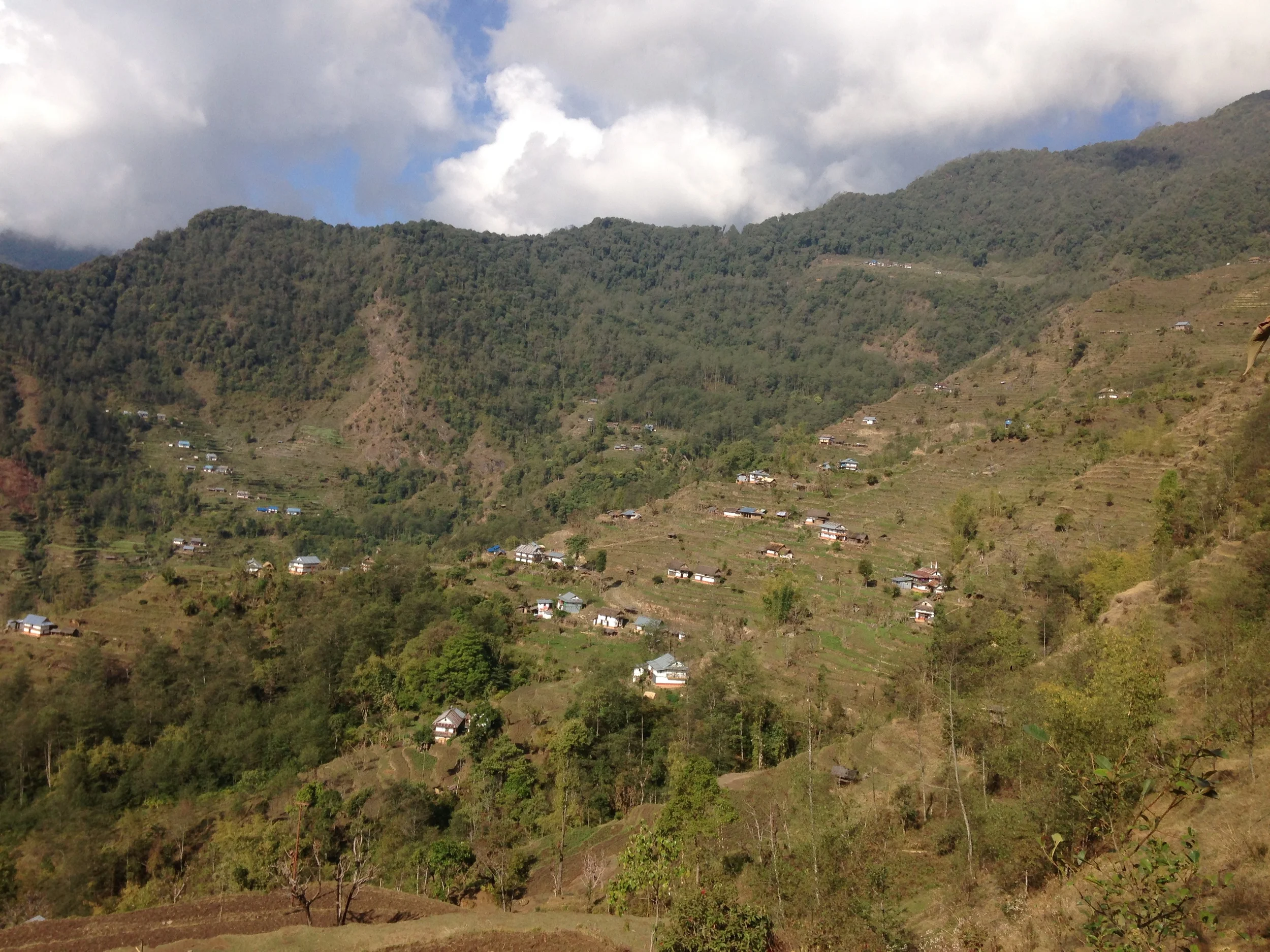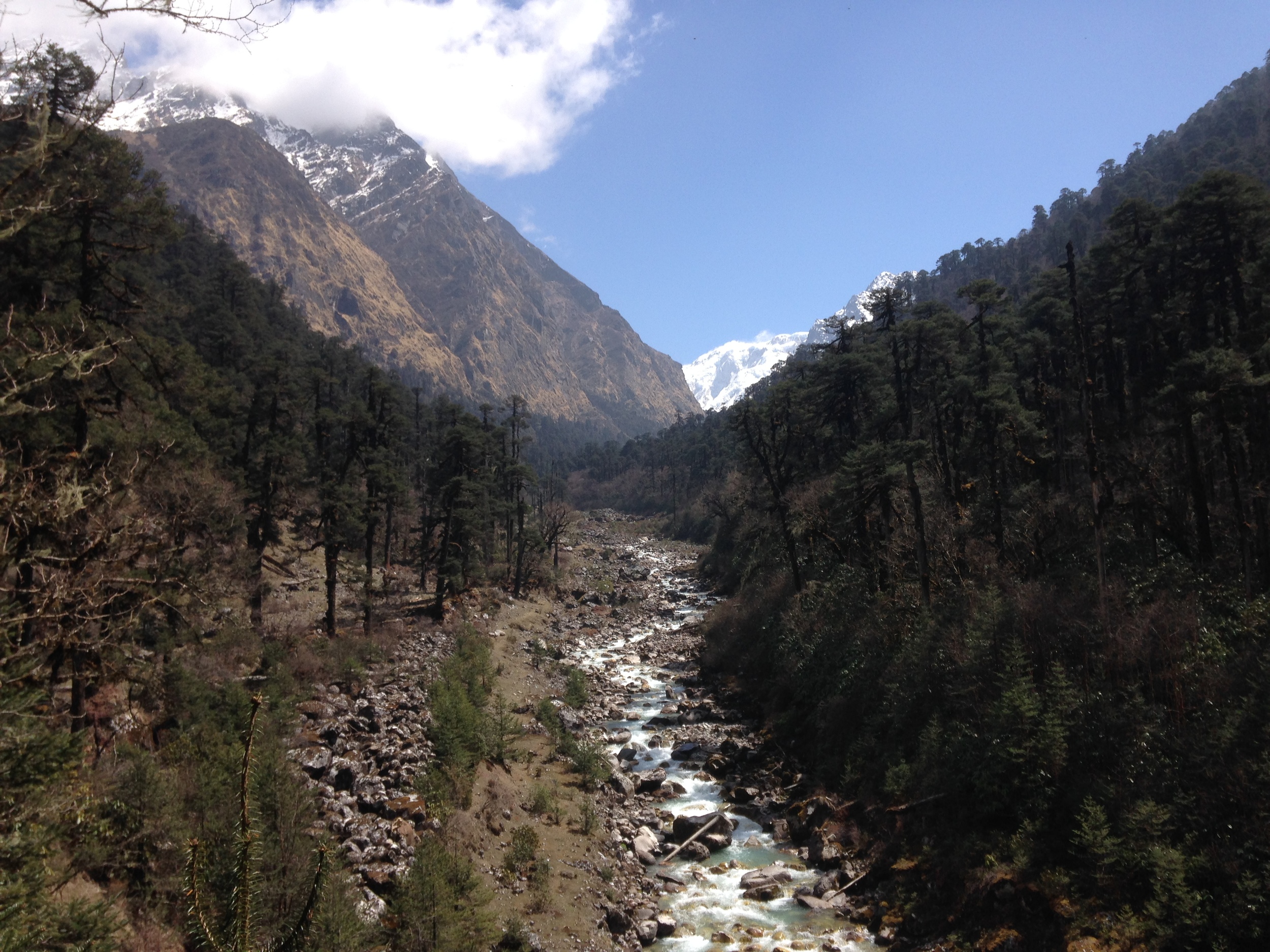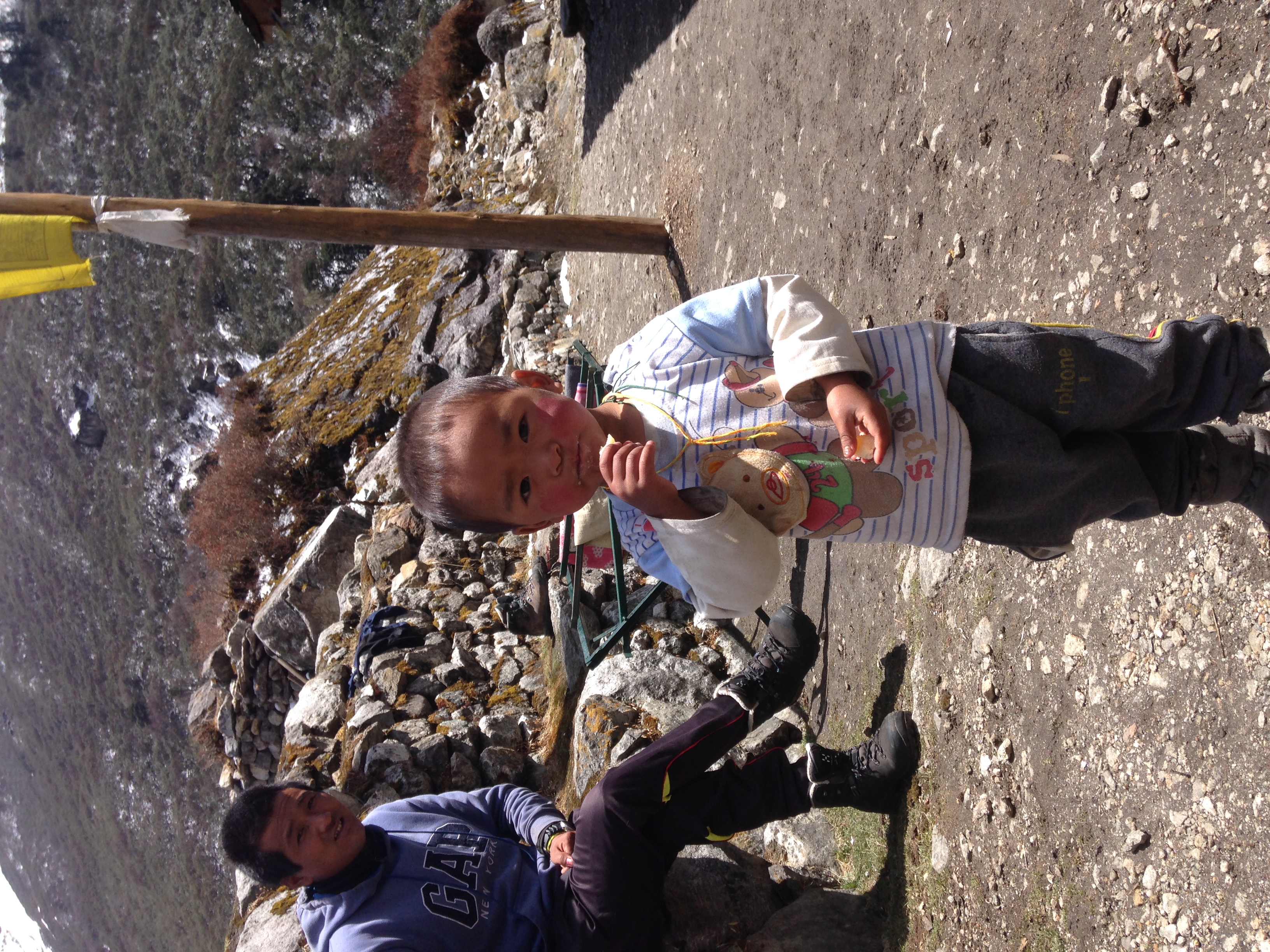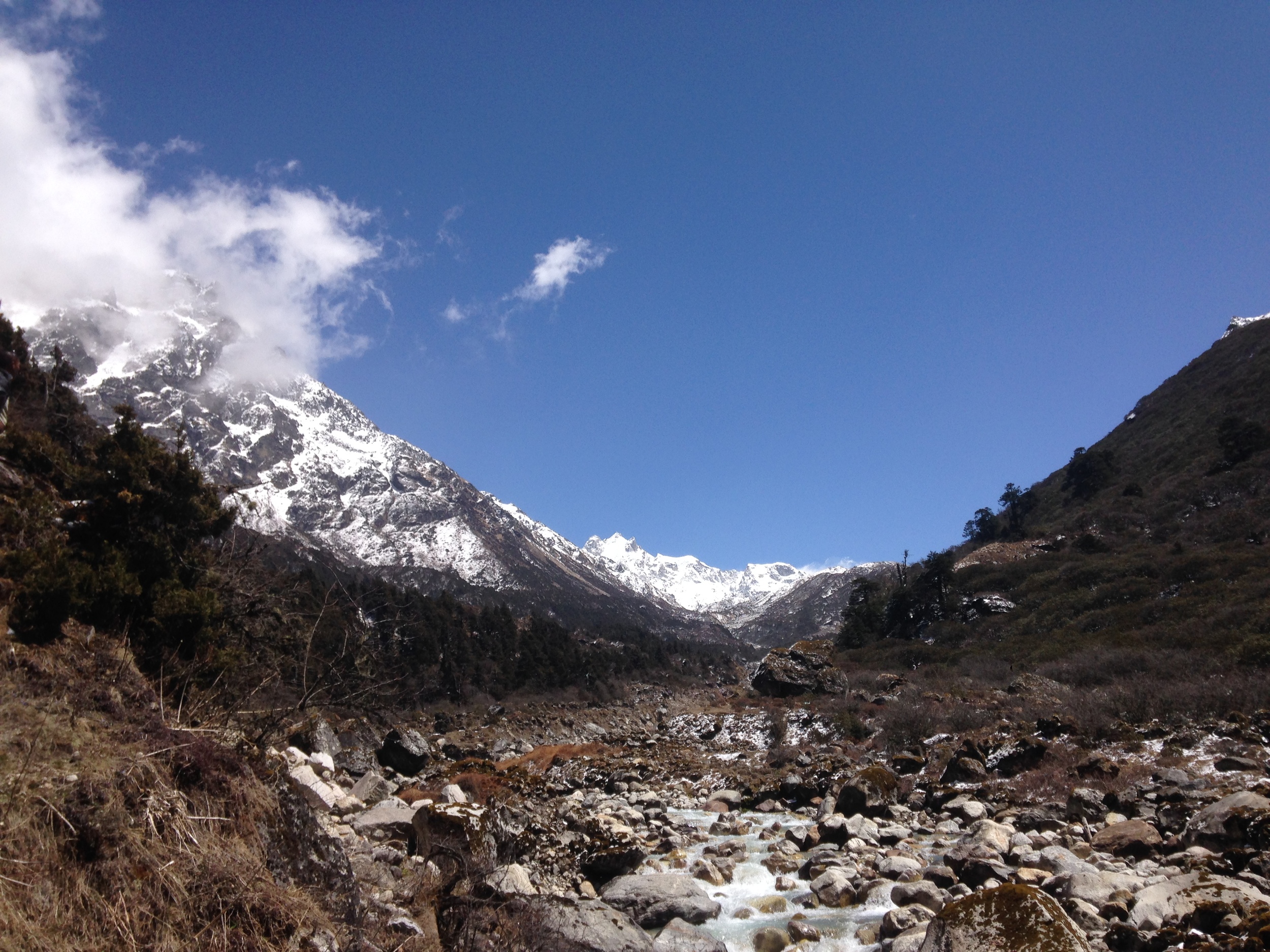The Ups and Downs of Mt. Kanchenjunga
Different from my time in India, there isn’t a long list of places I wanted to visit or things to do in Nepal. On my mind was a single task – go trekking. I wanted to spend time outside away from bustling people and honking horns and see how my body would adapt to high altitude.
In touristic Thamel of Kathmandu, the streets are lined with outdoor stores selling fake The North Face jackets and other hiking gear. Almost all of the equipment is fake, but that doesn’t necessary mean it won’t get the job done. I’d recommend bringing your own hiking shoes and if you rent a sleeping bag get the warmest one you can find. As I unfortunately found out later, a -10 degree Celsius bag will only keep you warm on its own at 5 degrees Celsius.
A stupa in Thamel, Kathmandu.
The first day in town Robert, Michael (our new Kiwi friend we met on the train from Varanasi) and I went popping into every other travel agency we could find. We wanted as much information on guide prices, trek costs, and different treks as we could get.
The Ups and Downs of Mt. Kanchenjunga
In the end, the decision was made to embark on an adventure to the base camps of Mt. Kanchenjunga, the third tallest mountain in the world standing at 8,586 meters high (28,169 feet). The main appeal was the solitude of the trek. Mt. Kanchenjunga is a two-day bus ride away from Kathmandu and gets very few trekkers compared to the Everest and Annapurna regions.
On the day we left Kathmandu we met up with our guide Mr. Moti. A Nepali man of unknown age, possibly as young as 27 or as old as 40, with a strong enough grasp of English to initially put you at ease as long as your questions revolve around food, sleeping, and hiking. With a scar on his forehead and a confidence inspiring demeanor we felt in good hands to begin our trek.
After a fourteen-hour night bus we stopped at Birtamod, just short of the India-Nepal eastern border towards Darjeeling. We got off the bus and climbed into a Mahindra jeep for an eight-hour journey on twisty roads up and down mountainsides to the town of Tapeljung, our starting point for the trek.
The view from out hotel in Tapeljung.
The Trail (Up/Down)
Kanchenjunga has two a south and north trail that lead to their respective base camps. Sele Pass that sits between Ghunsa on the north side and Cheram on the connects the two routes. Our plan was to head up the south trail to Yalung Base Camp, head back down to cross the pass, and proceed to Pangpengma Base Camp and return back to Tapeljung on the northern route.
The beginning of the trek was a series of trails connecting mountainside villages. Often lined to some extent with rocks, the trail was almost never level longer than a hundred feet. Instead, you are constantly winding your way up steep switchback pathways or heading downhill on trails that will leave all but the sturdiest knees sore at the end of the day.
Even without snow covered peaks in the first few days the vista of green rolling hills were incredible. Small huts, often isolated by kilometers on all sides, dotted the greenery. Whenever we descended down to the valley floor we would cross bouncing bridges above rushing rivers. The non-stop ascents could leave you breathless even at low altitude, but the views were always enough to keep you wanting more.
The Food & Alcohol (Up)
Welcome to the land of dal bhat power (24 hour!). Dal bhat (rice with lentil curry) was our nourishment for days on end. Sometimes accompanied with some greens or potatoes, dal bhat is a great source of energy and was the only option in the simple teahouses on the Kachenjunga trail. Every evening we would be asked by our guide, Mr. Moti, what we wanted for dinner as if their were options (which there not).
For breakfast we would often have an egg omelet, greens, and chapatti. Occasionally we stopped for lunch along the trail and be served noodles (top ramen style) spruced up with some veggies and chili powder.
When we reached the teahouse at Cheram (3870m), we had unknowingly walked into a food paradise for trekkers. For some reason they were stocked with the ingredients to make mac & cheese, chowmein, yak momos, crepes, and more. To my delight, the yak cheese piled on top of our macaroni tasted like Parmesan. The store at the teahouse had snicker bars and other delicacies we hadn’t seen since leaving Tapeljung. It was obvious the family running the teahouse at Cheram had been in the business for much longer than their colleagues lower down the trail.
A beautiful Mac & Yak Cheese picnic at Cheram.
From our first day trekking we were quickly introduced to the local alcoholic beverages. The moonshine that is often poured out of an old coke bottle or fuel container is called Raksi (also means drunk in Nepali). A Tibetan drink made from fermented millet and hot water that you drink from a perforated straw is called Tungba. There was also Chhaang that seemed similar to Tunga except for the fact that it came in a large bowl without millet in it.
Everything we ate tasted great. The dishes may be simple, but they were full of flavor and we enjoyed comparing the discussing the merits of each dal bhat compared to the ones we had previously enjoyed. Raksi aside, the alcohol was milder than beer and gave a nice buzz after a long day trekking.
The Guide (Up/Down)
From the beginning we weren’t sure what to make of our guide. Mr. Moti immediately made it clear that he was man that valued strength. He spoke of his time in China learning Kung Fu and showed off knuckles that had been repeatedly broken so that it could heal as a bone wall. When he spoke he often karate chopped the air or raised a menacing fist to emphasize his points. He loved to show the locals and us how he could hack away at a flexed forearm with a sharp knife and come away without a scratch.
He harbored an emotional side that showed true every time he had a little to drink. Beyond basic questions and answers our communication was rather limited. Moti worked hard to read our faces to understand whether or not we were happy with how things were going. Often confusing unhappiness with tiredness (especially when he was drunk), Moti would break into long tirades on how we were a team, how he would bargain on our behalf for cheap food and lodging, and how he wasn’t a commission man (when this is repeated over and over again you begin to wonder). He was committed to make sure we were happy and genuinely appeared upset or worried if he sensed we were not.
Perhaps this all came down to working for a good tip, but his rants grew overwhelming when we realized there was no chance at a two way conversation. He had things he wanted to say, he believed certain things were going on, and nothing we said would help. He either didn’t understand what we were saying or choose to not care.
Unfortunately his English seemed to deteriorate as we hiked and his responses to our questions consisted of “why not,” “difference is you,” “sure, sure, yes, yes,” and “this, this, this, ya know.” We never received a straight “yes” or “no.” I rarely had any clue what he was talking about and the trek began to seem more about the ups and down of Moti than the trail to base camp. Alone I would have been very concerned, but with two friends I was ready to take the long rants as long as we got to where we needed to go everyday.
His drinking actually became a problem that quickly escalated the first few days. Days where he had a drink or two with breakfast would leave him gasping for air in front us reeking of alcohol. Luckily the drinking more or less faded away as we hiked higher as I think he realized alcohol was helping him make a case for a good tip.
Mr. Moti!
On the other hand, he was clearly a favorite among the local people everywhere he stayed. We would hear people laughing and listening intently to his stories. He would often sing around the kitchen and it was clear he was a funny and entertaining man. I should also not forget that he was quick to point out plants, animals, and share any information about the area that he could.
There was a lot to Moti we did not understand, and a lot Moti probably didn’t understand about us. In the end though it was a great experience having him. After talking to other trekkers in Kanchenjunga and other treks we realized that we had been getting some great deals on food and lodging. Mr. Moti clearly had been looking out for best interests from the beginning. He added an interesting element to our trek that I will never forget.
The Weather (Down)
For the first half of the trek it rained every afternoon just after we arrived at our teahouse. It was only as we got higher that we realized that all the rain down below meant more and more snow up above.
As advertised, we didn’t see a single trekker over the first five days. When we arrived at the teahouse in Toranden, a days walk from the beginning of the pass that connects the north and south base camp routes, we encountered a large group of trekkers from New Zealand who brought with them the news we were dreading. The pass was closed and beyond the next teahouse on the trail nothing else was open. Some of the trekkers from New Zealand had attempted the pass but had quickly gotten stuck in snow up their chests and returned back. Needless to say I was mixture of disappointment, frustration, and upset at how helpless you can become in the face of Mother Nature.
The teahouse at Cheram getting snowed on.
It helped that we weren’t the only ones attempting to trek in Kanchenjunga and being turned back at the time. Apparently the weather we were facing was considered abnormal at this time of year. Determined to make the best of it we hiked up to Cheram, which sits at 3870 meters, and the following day we went on a day hike that brought us up to 4200 meters (or 4500 according to our guide, but I am bit skeptical). The views were stunning, but they left me aching to go even further.
Michael, Robert, and I at around 4200m high. Our highest ascent during the trek.
Returning back down we were at least able to take a slightly different route for the final two days to another village where we caught the first of two buses back to Kathmandu. On our way down it continued to rain almost every afternoon. The rain made me feel better about turning back and not waiting it out longer at the top in hopes of going further.
Back in Kathmandu
Our early arrival brought us back on the Nepali New Year’s Eve. Happy 2072! Although celebrations rang through the air, I was still racked with disappointment after failing to make it to either base camp or cross the pass at Kanchenjunga. After the trek I had been toying with the idea of volunteering in Nepal, but I knew that was no longer an option. I was hooked on the sights of the Himalayas and determined to make it to a base camp above 5000 meters before leaving Nepal.

